



The security cabinet on Sunday announced its approval of Defense Minister Israel Katz’s plan to construct a high-tech security barrier along the eastern border with Jordan to strengthen Israeli presence in the Jordan Valley.
The project — slated to begin in June — will include a 425-kilometer (264-mile) multi-layered defense system from Hamat Gader in Israel’s north to the Samar Sands, north of Eilat.
The NIS 5.2 billion ($1.4 billion) initiative is expected to take three years and will combine a physical barrier with advanced sensors, mobile military units and command infrastructure.
The plan also calls for bolstering Israeli presence in the Jordan Valley, which is part of the West Bank, by establishing “national mission centers,” including pre-military academies and national service frameworks.
Officials said strengthening the border will deter Iranian efforts to smuggle weapons into Israel and create a new terror front via Jordan.
“The establishment of a security fence along the Israel-Jordan border…is a critical strategic step against Iran’s attempts to turn the eastern border into another terror front,” said Katz.
“This is a strategic move that will bolster national security, reinforce our hold on the Jordan Valley, ensure Israel’s sovereignty for years to come – and deal a blow to Iran’s efforts to turn the eastern border into a terror front,” he added.
Work will begin on two priority segments totaling 80 kilometers (50 miles), while planning continues for the remainder of the fence. The project is being coordinated by an inter-ministerial team led by the Defense Ministry’s director general Maj. Gen. (res.) Amir Baram.
Currently, there is an aging chain link fence equipped with sensors along some of the border that Jordan shares with Israel and the West Bank. Other sections are only equipped with barbed wire.
The new fence will run from Hamat Gader at the southern edge of the Golan Heights to the Ramon International Airport north of Eilat. A 30-kilometer (18-mile) portion of the border with Jordan, from Eilat to Ramon Airport, was already upgraded in a similar fashion to Israel’s border barriers with Egypt and the Gaza Strip in the 2010s.
The border’s porousness has made it a site of frequent gun- and drug-running. Officials say that weapons that have made it over the border — likely tens of thousands over the past decade — have fueled a surge in violence in the Arab community in Israel, and have been used by Palestinian terrorists.
The idea of boosting the fence or building some sort of border wall has been floated repeatedly by Prime Minister Benjamin Netanyahu and others for more than a decade, although many see any such effort as unrealistic due to the sheer length of the border and the enormous cost.
The project was revived after the Hamas terror group’s October 7, 2023, attack started the ongoing war. The onslaught also demonstrated the limits of border infrastructure, as thousands of terrorists breached Israel’s NIS 3.5 billion ($1.1 billion), state-of-the-art border fence with Gaza, and proceeded to kill some 1,200 people and take 251 hostages.
Late last year, the Israel Defense Forces also announced the formation of a new division that will be tasked with defending the country’s border with Jordan.
In a statement, the IDF said the decision to launch the new eastern regional division was made following an examination of the military’s “operational needs and defense capabilities in the area, in accordance with the planning of the IDF’s force build-up, in the light of the lessons of war and the situational assessment.”


